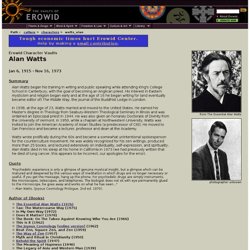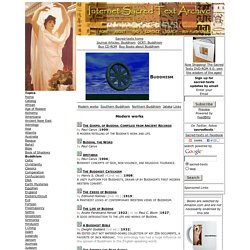

Terence mckenna. Local buddism. Where is the call to legalize psychedelics? : Drugs. Alan Watts Vault. Alan Watts began his training in writing and public speaking while attending King's College School in Canterbury, with the goal of becoming an Anglican priest.

His interest in Eastern mysticism and religion began early and at the age of 16 he began writing for (and eventually became editor of) The Middle Way, the journal of the Buddhist Lodge in London. In 1938, at the age of 23, Watts married and moved to the United States. He earned his Master's degree in Theology from Seabury-Western Theological Seminary in Illinois and was ordained an Episcopal priest in 1944. He was also given an honarary Doctorate of Divinity from the University of Vermont. In 1950, while a chaplain at Northwestern University, Watts was invited to join the American Academy of Asian Studies (a predecessor of CIIS).
Watts wrote prolifically during the 60s and became a somewhat unintentional spokesperson for the counterculture movement. Podcast Archives.
Rajneesh. Buddha, The Word (the Eightfold Path) 500 BC BUDDHA, THE WORD (The Eightfold Path) THE FOUR NOBLE TRUTHS THUS has it been said by the Buddha, the Enlightened One: It is through not understanding, not realizing four things, that I, Disciples, as well as you, had to wander so long through this round of rebirths. And what are these four things? Buddha, The Word (the Eightfold Path) Sacred Texts: Buddhism. Sacred-texts home Journal Articles: Buddhism OCRT: Buddhism Buy CD-ROM Buy Books about Buddhism Modern works Southern Buddhism Northern Buddhism JatakaLinks Modern works The Gospel of Buddha: Compiled from Ancient Records by Paul Carus [1909]A modern retelling of the Buddha's work and life.

Buddha, the Word by Paul Carus Amitabha by Paul Carus [1906]Buddhist concepts of God, non-violence, and religious tolerance. The Buddhist Catechism by Henry S. The Creed of Buddha by Edmond Holmes (2nd. ed.) [1919]A Pantheist looks at contemporary Western views of Buddhism. The Life of Buddha by Andre Ferdinand Herold [1922], tr. by Paul C. A Buddhist Bible by Dwight Goddard (1st ed.) [1932]An edited (but not watered-down) collection of key Zen documents, a favorite of Jack Kerouac. The Smokey the Bear Sutra by Gary Snyder.A much beloved short poem about the relationship between Buddhism and ecology, written by one of the 'beat' era poets, simultaneously funny and profound. Southern Buddhism Jataka BBS Files. Noble Eightfold Path. The Dharma wheel, often used to represent the Noble Eightfold Path.

Six Yogas of Naropa. The Six Yogas of Nāropa (Tib.

Narö chö druk, na-ro'i-chos-drug), also called the six dharmas of Naropa.[1] Naro's six doctrines (Mandarin: Ming Xing Dao Liu Cheng Jiu Fa; rendered in English as: Wisdom Activities Path Six Methods of Accomplishment),[2] are a set of advanced Indo-Tibetan Buddhist tantric practices and a meditation sādhana compiled in and around the time of the Indian monk and mystic Nāropa (1016-1100 CE) and conveyed to his student Marpa the translator.
Bodhicitta. Etymology[edit] Etymologically, the word is a combination of the Sanskrit words bodhi and citta.

Bodhi means "awakening" or "enlightenment". Citta derives from the Sanskrit root cit, and means "that which is conscious" (i.e., mind or consciousness). Bodhicitta may be translated as "awakening mind" or "mind of enlightenment". Spontaneity[edit] Bodhicitta is a spontaneous wish to attain enlightenment motivated by great compassion for all sentient beings, accompanied by a falling away of the attachment to the illusion of an inherently existing self. The mind of great compassion and bodhicitta motivates one to attain enlightenment Buddhahood, as quickly as possible and benefit infinite sentient beings through their emanations and other skillful means. A person who has a spontaneous realization or motivation of bodhicitta is called a bodhisattva. Bodhisattva.
Amitābha. Portrait of Buddha Amitābha attached in Annotation to the Infinite Life Sutra (Ch.

佛說大乘無量壽莊嚴清淨平等覺經科註) Jiriki. Jiriki (自力?

, one's own strength[1]) - here: the Japanese Buddhist term for self power, the ability to achieve liberation or enlightenment (in other words, to reach nirvana) through one's own efforts. Jiriki and tariki (他力 meaning "other power", "outside help") are two terms in Japanese Buddhist schools that classify how one becomes spiritually enlightened.[2] Jiriki is very much urged and practiced in Zen Buddhism.
In Pure Land Buddhism, tariki often refers to the power of Amitābha Buddha.[3] These two terms describe the strands of practice that followers of every religion throughout the world develop. In most religions you can find popular expressions of faith which rely on the worship of external powers such as an idol of some kind that is expected to bestow favor after being given offerings of faith from a believer. Jiriki is experiencing truth for oneself and not merely accepting the testimony of another. References[edit] Further reading[edit] Ford, James L. (2002). Jiriki.